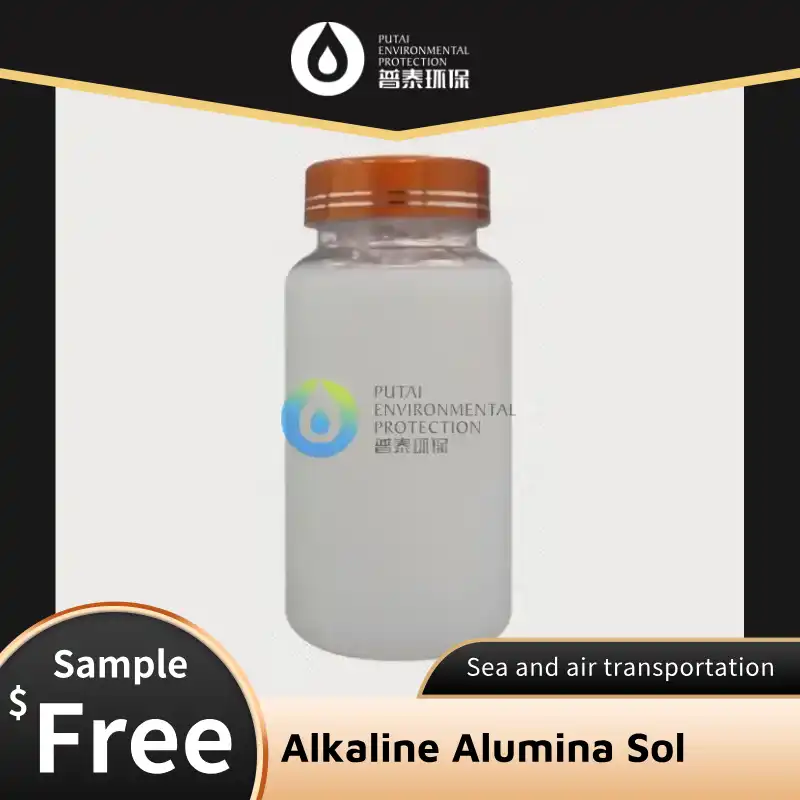Sol-Gel Technology: Alkaline Alumina Sol's Role in Coatings
In the dynamic realm of materials science, sol-gel technology has emerged as a groundbreaking approach to creating advanced coatings. At the heart of this innovation lies the alkaline alumina sol, a versatile component that's revolutionizing the way we think about protective and functional surfaces. This blog post delves into the intricacies of sol-gel technology, with a particular focus on the pivotal role played by alkaline alumina sol in enhancing coating performance.
Sol-Gel Process: A Coating Revolution
The sol-gel process represents a paradigm shift in coating technology. This innovative method involves the transformation of a liquid 'sol' (a colloidal suspension) into a solid 'gel' network. The process begins with the hydrolysis of precursor compounds, typically metal alkoxides or metal chlorides. These precursors undergo condensation reactions, forming a network of metal-oxygen-metal bonds.
What sets sol-gel apart is its ability to produce high-purity, homogeneous materials at relatively low temperatures. This characteristic makes it particularly suitable for creating thin films and coatings with precisely controlled composition and structure. The versatility of sol-gel technology allows for the incorporation of various functional additives, opening up a world of possibilities for tailored coating properties.
In the context of coatings, sol-gel technology offers several advantages:
- Enhanced durability and scratch resistance
- Improved adhesion to substrates
- Increased chemical and corrosion resistance
- Ability to create multifunctional coatings
- Low-temperature processing, suitable for heat-sensitive substrates
These benefits have led to the widespread adoption of sol-gel coatings such as Alkaline Alumina Sol in various industries, from automotive and aerospace to electronics and biomedical applications.
Alkaline Alumina Sol: Perfecting the Sol-Gel Method
Within the broader spectrum of sol-gel technology, alkaline alumina sol has carved out a niche as a crucial component in high-performance coatings. Alumina, or aluminum oxide (Al2O3), is renowned for its exceptional hardness, chemical inertness, and thermal stability. When formulated as an alkaline sol, these properties are harnessed in a form that's ideally suited for sol-gel processing.
The alkaline nature of this alumina sol offers several advantages in coating applications:
- Enhanced Stability: The alkaline environment helps maintain the colloidal stability of the alumina particles, preventing premature aggregation and ensuring a uniform distribution in the final coating.
- Improved Reactivity: Alkaline conditions can accelerate certain sol-gel reactions, leading to more efficient film formation and curing.
- Compatibility with Substrates: Many substrates, particularly metals, exhibit better compatibility with alkaline systems, resulting in improved adhesion and coating integrity.
- Tailored Porosity: The alkaline environment allows for better control over the pore structure of the resulting gel, which can be crucial for applications requiring specific permeability or surface area characteristics.
The incorporation of alkaline alumina sol in sol-gel coatings has led to remarkable improvements in coating performance across various applications:
- Wear-Resistant Coatings: The inherent hardness of alumina translates into exceptional wear resistance, making these coatings ideal for high-abrasion environments.
- Corrosion Protection: Alumina-based sol-gel coatings form an effective barrier against corrosive agents, protecting underlying substrates in harsh chemical environments.
- Thermal Barrier Coatings: The high thermal stability of alumina makes it an excellent choice for coatings that need to withstand extreme temperatures.
- Optical Coatings: The ability to control the refractive index and transparency of alumina sol-gel coatings has led to their use in antireflective and other optical applications.
The versatility of alkaline alumina sol in sol-gel coatings extends beyond these applications. Its compatibility with other sol-gel precursors allows for the creation of hybrid coatings that combine the benefits of alumina with those of other materials, such as silica or zirconia. This synergistic approach opens up new possibilities for tailoring coating properties to meet specific performance requirements.
Future Prospects: Advancing Sol-Gel Coating Technology
As we look to the future, the role of alkaline alumina sol in sol-gel coating technology is poised for further growth and innovation. Several emerging trends and research directions are shaping the evolution of this field:
- Nanostructured Coatings: The ability to control the size and morphology of alumina nanoparticles in the sol opens up possibilities for creating coatings with unprecedented properties. Researchers are exploring ways to leverage the unique characteristics of nanostructured alumina to enhance coating performance in areas such as self-cleaning, antimicrobial activity, and sensing capabilities.
- Smart Coatings: The integration of alkaline alumina sol with responsive materials is paving the way for smart coatings that can adapt to their environment. These could include coatings that change color in response to temperature or pH, or those that release active compounds on demand.
- Sustainable Processing: As environmental concerns take center stage, there's a growing focus on developing more sustainable sol-gel processes. This includes exploring water-based systems, reducing the use of harmful solvents, and optimizing energy consumption during coating production and application.
- Multi-Layer Architectures: Advanced coating systems are increasingly utilizing multi-layer architectures to achieve complex functionalities. Alkaline alumina sol can play a crucial role in these systems, serving as a robust base layer or as a functional interlayer to enhance overall coating performance.
- In-Situ Reinforcement: Research is underway to develop sol-gel coatings that can self-reinforce or self-heal. By incorporating reactive components that can form additional cross-links or fill gaps over time, these coatings could offer unprecedented durability and longevity.
The potential applications for advanced sol-gel coatings incorporating alkaline alumina sol are vast and continue to expand. Some areas of particular interest include:
- Energy Sector: Coatings for solar panels that enhance efficiency and durability, or protective coatings for fuel cells and batteries.
- Healthcare: Biocompatible coatings for medical implants that promote osseointegration or prevent bacterial adhesion.
- Aerospace: Ultra-high temperature ceramic coatings for next-generation aircraft and spacecraft components.
- Electronics: Functional coatings for flexible electronics and wearable devices, offering protection against environmental factors while maintaining device performance.
As research in this field progresses, we can expect to see increasingly sophisticated sol-gel coatings that push the boundaries of material performance and functionality. The unique properties of alkaline alumina sol, combined with ongoing advancements in sol-gel processing techniques, position this technology at the forefront of coating innovation.
Conclusion
The integration of alkaline alumina sol in sol-gel coating technology represents a significant leap forward in materials science. From enhancing durability and wear resistance to enabling smart, multi-functional surfaces, the applications of this versatile material continue to expand. As we look to the future, the potential for further innovation in this field is immense, promising coatings that are not only more effective but also more sustainable and adaptable to our changing needs.
For those in the water treatment and environmental protection industries, the applications of sol-gel technology and alkaline alumina sol extend beyond traditional coating applications. These advanced materials offer exciting possibilities for improving water purification processes, developing more efficient filtration systems, and creating surfaces that resist fouling and contamination.
If you're interested in exploring how these cutting-edge technologies can benefit your operations, we invite you to reach out to our team at Xi'an PUTAI Environmental Protection Co., Ltd. With over 20 years of experience in water treatment chemicals and a commitment to innovation, we're well-positioned to help you leverage the power of advanced materials like alkaline alumina sol in your environmental protection efforts.
Contact us today at sales@ywputai.com to learn more about our products and services, and discover how we can work together to create more efficient, effective, and sustainable solutions for water treatment and environmental protection.
References
1. Wang, D., & Bierwagen, G. P. (2009). Sol–gel coatings on metals for corrosion protection. Progress in Organic Coatings, 64(4), 327-338.
2. Sakka, S. (2013). Sol-gel technology for thin films, fibers, preforms, electronics and specialty shapes. Springer Science & Business Media.
3. Brinker, C. J., & Scherer, G. W. (2013). Sol-gel science: the physics and chemistry of sol-gel processing. Academic press.
4. Guglielmi, M., Kickelbick, G., & Martucci, A. (Eds.). (2014). Sol-gel nanocomposites. Springer.


